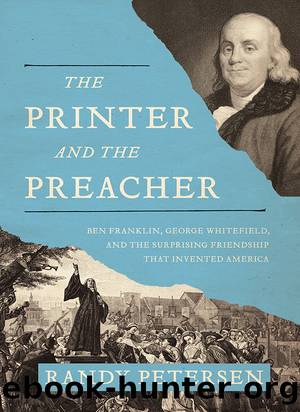The Printer and the Preacher by Randy Petersen

Author:Randy Petersen
Language: eng
Format: epub
Tags: ebook
Publisher: Thomas Nelson
Published: 2015-03-01T00:00:00+00:00
SEVENTEEN
Face to Face
âThe Reverend Mr. Whitefield preached to about 10,000 people, at Kensington Common. This day he is to preach at Wapping Chapel for the benefit of the Orphan House in Georgia.â1
So wrote Ben Franklin in the Pennsylvania Gazette a year before he met this preacher. Clearly he was aware, at least vaguely, of Whitefieldâs ministry and his growing fame. Ben scanned the London papers for news from the old country and printed what seemed interesting to his readers. Like any good newsman, he would have kept an eye out for âMan Bites Dogâ storiesâtales of the unexpected and twists on familiar themes. Ben might have been bemused by the thought of a preacher drawing crowds not in churches, but in open fields. Or maybe he just needed to fill three lines on page one.
On November 8, 1739, Ben printed this news item: âLast week the Rev. Mr. Whitefield landed from London at Lewes-Town in Sussex County, where he preached, and arrived in this city on Friday night, on Sunday, and every day since he has preached in the church. And on Monday he designs (God willing) to set out for New York, and return hither the week after, and then proceed by land through Maryland, Virginia and Carolina to Georgia.â2
Benâs dates agreed with Georgeâs journal. He arrived in Philadelphia on Friday, November 3, and quickly rented a room downtown, within a block or two of Ben Franklinâs printing office. He had in fact preached at Christ Church, as Ben reported, in the days since his arrival. It was the evening of Thursday, November 8 (the day the paper came out), when he began preaching from the Courthouse steps, drawing larger crowds than ever. This continued on Friday and Saturday nights.
That same November 8 issue of the Pennsylvania Gazette carried a for-sale ad:
To be sold, at the house of the Rev. Mr. Whitefield, in Second-Street (the same in which Capt. Blair, lately dwelt) the following goods: being the benefactions of charitable people In England, towards building an orphan-house in Georgia:
Brass Candlesticks, Snuffers and snuff-Dishes, four, six, eight, ten and twenty-penny Nails, Pidgeon, Duck and Goose Shot, bar Lead, Pistol Powder in quarter and half Barrels, English Duck Numb. 1, 2, 3, and 4, English Cordage, Ratling, Worming, Marline and Spun-yarn, Ruggs and Blankets, Duffills stripâd, Drills for Bed-sacking, seven eighths and three quarter Garlix, white Roles, white Hessins, Russia Hempen Ditto; narrow Lawns, Scotch Cloth, cotton Romalls, Seirsuckers, white Dimities, Carradaries, Cherconees, long Romalls, colourâd Ginghams with Trimings, Gorgoroons black, black Persian Taffities, stripâd Linseys, Swanskin Bays, broad Cloth, Shalloons, long Ells, Buttons, Buckrams, and sewing-Silk.3
Ingeniously, George was mixing charity and commerce. Using money donated for the orphanage, he had bought these goods in England and transported them to Philadelphia for the express purpose of selling them at a profit. In this way he leveraged the donations, creating even more of a bankroll for the Savannah orphan house. We can only imagine what his rented room must have looked like, or what the landlord thought as he saw the merchandise carted in.
Download
This site does not store any files on its server. We only index and link to content provided by other sites. Please contact the content providers to delete copyright contents if any and email us, we'll remove relevant links or contents immediately.
Getting It, Then Getting Along by L. Reynolds Andiric(631)
Religion and Politics Beyond the Culture Wars : New Directions in a Divided America by Darren Dochuk(451)
Global Justice, Christology and Christian Ethics by Lisa Sowle Cahill(411)
Positive Psychology in Christian Perspective: Foundations, Concepts, and Applications by Charles Hackney(342)
Forgiveness and Christian Ethics by Unknown(329)
Douglas Hamp The First Six Days by Unknown(257)
The Horrors and Absurdities of Religion by Arthur Schopenhauer(243)
Insurgency, Counter-insurgency and Policing in Centre-West Mexico, 1926-1929 by Mark Lawrence(234)
Christian Martyrdom and Christian Violence by Matthew D. Lundberg;(223)
The Oxford Handbook of Greek and Roman Mythography by R. Scott Smith;Stephen M. Trzaskoma;(217)
Beyond Heaven and Earth by Gabriel Levy(210)
God and Eros by Patterson Colin;Sweeney Conor;(208)
The Bloomsbury Reader in Christian-Muslim Relations, 600-1500 by David Thomas;(205)
Autobiography, Volume 2: 1937-1960, Exile's Odyssey by Mircea Eliade(197)
Cult Trip by Anke Richter(194)
Witches: the history of a persecution by Nigel Cawthorne(192)
An Introduction to Kierkegaard by Peter Vardy(179)
The Myth of Disenchantment by Jason A. Josephson-Storm(174)
The Global Repositioning of Japanese Religions by Ugo Dessi(173)
